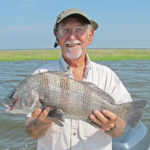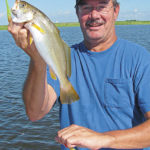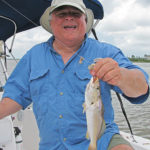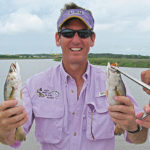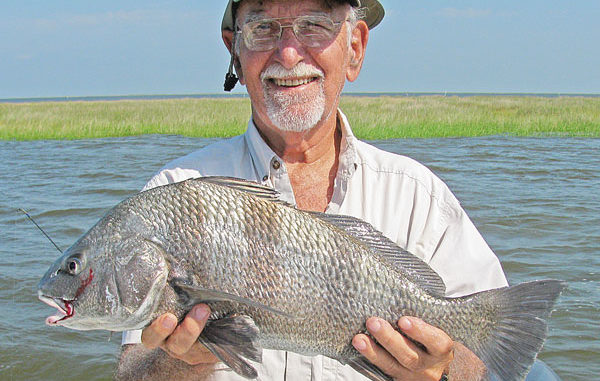
This area doesn’t get the acclaim it once did, but it’s certainly not because the fishing isn’t as good as ever.
The fishing was pathetic. Everyone whined and moaned — all except Eddie, who grinned wickedly. His eyes twinkled as he looked around the boat.“No mas!” he finally blurted and reached for his knapsack.
Pelayo frowned and shrugged as Eddie started rummaging.
“To heck with all this fishing,” Eddie snorted, “Time to get serious about some catching!”
He jerked out his binoculars.
“Now, NOW boys,” Pelayo sighed. “At least be a little discreet, will ya!”
He nudged Eddie, who stood prominently astern, focusing his binoculars on the lone figure in a boat no more than 80 yards away. The lone gentleman had already shown signs of displeasure when we’d burst upon the scene earlier, craning our necks in his direction as he lowered his pole trying to disguise that it was bent. He then moseyed around to the opposite side of the boat to lift the fish aboard, thinking he was hiding it with his body.
After chunking it in his box, he turned around to see that Eddie had rumbled to barely half a football field of his boat.
Then … .
Remember the WWII sub movie Run Silent, Run Deep? Remember the depth charges? If so, you’ll spare me from trying to describe the results of Eddie’s deft anchor-throwing technique. The lone fisherperson’s ponytail and tie-dyed T-shirt fooled us into thinking he was giving us the peace sign in response. But closer inspection revealed that only one finger was upraised.
For half an hour, the guy had been cranking fish aboard steadily. They looked like trout (both specks and whites), and also what looked like some beautiful bull croakers, that mainstay of so many Chef and Rigolets area fishing trips back in the 1960s and ’70s. They looked about the size of the one the guy reeled aboard his wooden lapstrake boat in the old Shoreline Park commercial: “High ground you walk on before you buy!” Then Morgus the Magnificent would come back on.
That was a day when bull croakers, puppy drum, channel mullet and white trout were hauled in while bottom fishing with dead shrimp on shad rigs or plain hooks (not kahle).
Amazingly enough many of these fish were — now hold on to your hats — SCALED!! Then gutted and fried whole. And they were absolutely dynamite: crispy skin, juicy flavorful interior meat. Amazingly enough, specks were also caught in this manner, but they were rarely the main catch.
“Great, now crank up the power on those binoculars, Eddie!” Chris hissed. “See what the guy’s using. Live bait? Gulps? Beetles? What color? We need some fish, man!”
“He ain’t using no live bait,” Eddie hissed back as he raised the binoculars. “I can see that from here. Now let’s see what he’s using.”
“You guys are UNREAL,” Pelayo snorted. “He ain’t using live bait, and he ain’t using any kinda special lure or gizmo that we ain’t got a ton of right here in every one of our tackle boxes!”
Pelayo held up his pole displaying the newly attached tandem sparkle beetles.
“I finally realized our problem. We just couldn’t get the bait … .”
“Aw, come on!” yelled Chris. “We been casting for half an hour with those, and we ain’t … .”
“WHATCHIT!” Eddie suddenly yelled. “The guy’s starting to look over — think he’s on to us. Think he’s getting a little PO’d.”
“Heck, he’s BEEN PO’d” Pelayo said. “And, seriously, you guys blind or something? Like I was saying, with the depths here and the strong current and all, we gotta … .”
“He sure don’t look, happy,” Chris said pointing with his chin and grimacing.
We looked over, and sure enough, the guy was looking straight at us, nodding disgustedly, arms in the air. Then he threw his pole down, stomped onto the bow and started hauling up his anchor.
“Knock yourselves out!” he yelled. “I got my limit!”
He stomped back to the wheel and cranked up the engine, which came alive with a ghastly roar. Then he revved it a couple times for full effect. Then he slammed it into gear, and the boat shot forward like a souped up Chevy at the old LaPlace dragway. Then he turned sharply, shooting up a huge rooster tail.
“Hey, MAN!” Chris yelled and started waving.
“Hey! WATCHIT!” Eddie dropped his binoculars and chimed in. “You CRAZY or something?”
By then the boat was barely 40 yards away, looking to “cross our T” and closing in fast.
Pelayo threw down his rod and leaped to the bow followed closely by the rest of us. At about 10 yards, the guy turned sharply, drenching us with his rooster tail as his 200 roared and cavitated away. In seconds, Pelayo was in hysterics.
“Man, it was getting HOT out here!” he cackled as we rocked from the wake. “I was about to jump in!”
“Yeah, you right!” Eddie added. “Now everything’s COOL, Daddy-O!” and he adjusted his dripping sun shades for added effect.
“Gotta admit that little shower was nice,” Chris said while wiping his shades and shaking his hair like his lab just in from retrieving a merganser.
“Now, like I was saying before we were so rudely interrupted, “Pelayo sighed as he picked up his dripping pole. “Look CLOSELY at my tandem jigs — 1/2-ounce each, SEE? Problem was with one 3/8-ounce, our bait just wasn’t getting to the bottom. We all had different-colored plastic. But that wasn’t the issue.
“Look at this current. Kinda like fishing The Jump during fall. Same thing here. We gotta fight this current to get our bait deep to where the fish are.
“And look at the depth finder, man. Water goes down to 40 feet here. There’s ledges too. My guess is that guy had pinpointed one of those deep ledges, and he was getting his bait down there with a big jighead. He wasn’t using live bait — though I doubt that would hurt here.
“Let’s set up RIGHT!” Pelayo insisted as he grabbed the anchor. “Now check the depth gauge,” he instructed Eddie, “and see when we hit the ledge, when the water changes quickly from about 25 to 8 feet or so. We want to fish the ledge. The fish are all stacked up on the ledge.”
The hellacious currents that run through this area have scoured a pretty deep channel. We watched the depthfinder go from 5 to 10 to — WHOOA! — 20, 30 then 50 feet!
“Hold on, hold ON!” Pelayo cautioned as he jammed the boat in reverse.”OK drop it!” he yelled, and I slid the anchor over in an area of 8- to 10-foot depths. “We’ll all be casting that-a-ways!” Pelayo pointed.
This meant we’d be casting in the direction of the 25- to 30-foot depths, but not actually INTO those depths — rather, into the fairly steep ledge where it started descending from 12 feet or so.
Three casts later, Pelayo pulled in a pair of frying-sized white trout. So Chris, Eddie and I all scrambled to the tackle boxes for the heavy jig heads. You’d think after 40 years of fishing, something so basic mighta sunk in earlier. But such is late-summer fishing. You get in a rut chasing tiny specks under the birds, using popping corks, and it doesn’t occur that bigger specks, along with a ton of white trout and croakers, like it much, much deeper at times. Heck, just think of where you catch fish outta Seabrook. Not exactly the shallows.
“Heck, man,” Pelayo snorted. “These westerly winds we’ve been having for the past two months got the tides super low. So we ain’t gonna ambush too many reds and puppy drum along the marsh shorelines right now. This place is the ticket.”
We’d launched from Bayou Bienvenue at Bait, Inc., then up to the Intracoastal, then hung a right and headed east to the deep-water, current-washed bottlenecks where Lake Pontchartrain and its surrounding marshes empty (or fills from, depending on tide direction) Lake Borgne, which is technically an extension of Breton Sound.
Every one who grew up in New Orleans remembers “The Chef” as perhaps the area’s premier a croaker/white trout “hole.” This meant fishing deep, in the pass itself, or at the mouths of any cuts leading into it. And using shrimp-baited hooks above sinkers (how odd that term sounds nowadays for inside fishing).
The mouth of Bayou Thomas, about 2 miles west of Chef Pass along the Intracoastal, features a similar setting.
Soon all our poles were rigged with tandem heavy jigs and chartreuse and white/purple tails.
“Yeah!” Pelayo yelled from the bow with his rod high overhead as the rest of us made our first cast in this new location. “Just watch! … Whoops! There’s the second one!” and he seemed to set the hook again.
All eyes were on Pelayo as, whooping like a lunatic, he swung aboard a pair — one white the other a speck (a pattern that appeared often throughout the day).
“Perfect!” he beamed. “Look at ’em!”
They wriggled and shone in the afternoon sun. In the old days, a speck this size we’d call a “cigar trout.” They were great fried whole — and these would be too.
If specks, many of the white’s we caught would have been borderline. The kind you smash and stretch against the ruler, reaching for that magic 12. With white trout, there’s no such concern (no size or even creel limits). And an added treat: White trout have slender, tender bones to begin with. When it’s a small trout, the bones are all the more tender. Just a little frying pretty much renders them into mush, which means you can suck the luscious white meat off the backbone without much fear of getting a hard rib bone caught in your throat.
I’d been retrieving slowly while watching Pelayo, and soon I felt a lunge (a white trout REALLY smacks a bait).
“Whoa!” I grunted, and soon I felt another lunge. “Bet I got two!” I roared.
But nobody noticed. They were all too busy with their own fish, two of which were nice bull croakers. Interestingly, Pelayo’s had hit without an enticement from shrimp.
“These suckers must be stacked up down there,” Pelayo surmised as he unhooked the golden beauty.
The whoops soon drowned out even the Mick and Keith and John, Paul & Ringo on our boom box (hey, if you’re going to fish like in the Morgus days, you’ve got to listen to the same music as back then).
Eddie swung aboard a white trout, smartly smacking my cheek with the free beetle in the process. And Chris would have swung in two, but one dropped off in his frenzy to get them aboard. We did away with the shrimp-tipping, and it made no difference whatsoever, except for Chris who needed some puppy drum for the grill. Chris cast back out, and reared back the instant he took up the slack. His medium rod bowed deeply.
“Don’t think that’s no white trout or croaker!” Pelayo shouted.
“No way!” Chris nodded as his drag sang away.
“Bet it’s a puppy drum.” Pelayo smirked from the bow. “They love this channel too.”
After a five-minute back-and-forth tussle, I slid the net under Chris’ drum, about a 4-pounder.
“We won’t be just frying fish tomorrow folks!” Pelayo roared. “We’ll be grilling some gorgeous fillets on the half-shell too!”
Over half the fish Pelayo was swinging aboard, for some odd reason, were specks.
“Watch where I’m casting,” he smirked when Eddie made the observation.
“See?” Pelayo grinned. “I’m casting UPcurrent, toward the anchor.”
“OK, big deal!” Chris laughed.
“Now watch,” and Pelayo took up his slack, bounced his rod tip a bit — WHAM! “There he is!”
Sure enough, another 16-inch speck was soon aboard.
“Gotta theory here,” he said while chunking his fish in the box. “Trout probably know shrimp don’t swim AGAINST a current, at least one this strong. They know such a current usually carries the shrimp WITH it. So I’m making my jigs do that. Instead of retrieving them AGAINST the current, I’m letting them bounce WITH the current, like a shrimp does naturally.”
Whatever, it sure seemed to work.
No sooner had I put down the net after scooping up another Pelayo trout, I picked up my rod, felt a tap (on my shrimp-tipped jig) and set the hook on something heavy.
“Feels like another drum here!”
In a few minutes, Pelayo was returning the favor by netting my 4-pound puppy drum.
Eddie, in the meantime who had followed my advice with shrimp, groaned as he reached for the flipper. Over the side, a big gafftop was busy sliming his line.
“Check it out!” Pelayo announced from the bow.
We all looked up and saw he had another speck — but an outsized one (by our standards), about a 2-pounder. “Told ya!” he shouted.
Chris then swung in a double consisting of a school speck and a channel mullet.
This first half hour set the pattern for the next two hours. Literally every cast (with or without shrimp) produced either several hits or a fish — nothing really big, except the few puppy drum, but all great frying. The box was filling nicely as Pelayo snapped open his cell-phone.
“Yep!” he informed Doc Fontaine. “The fish fry is definitely ON for tomorrow! Invite the whole neighborhood, and make sure you’re kayaking brud-in-law comes. We need some amusement!”
We only lifted the anchor once after our tie-dyed friend drenched us — to head back to the launch. Back home, we counted out 111 fish, mostly white trout from 10-13 inches, with a smattering of puppy drum, bull croakers, channel mullet and specks. A nice box, even in the days of Morgus the Magnificent.
